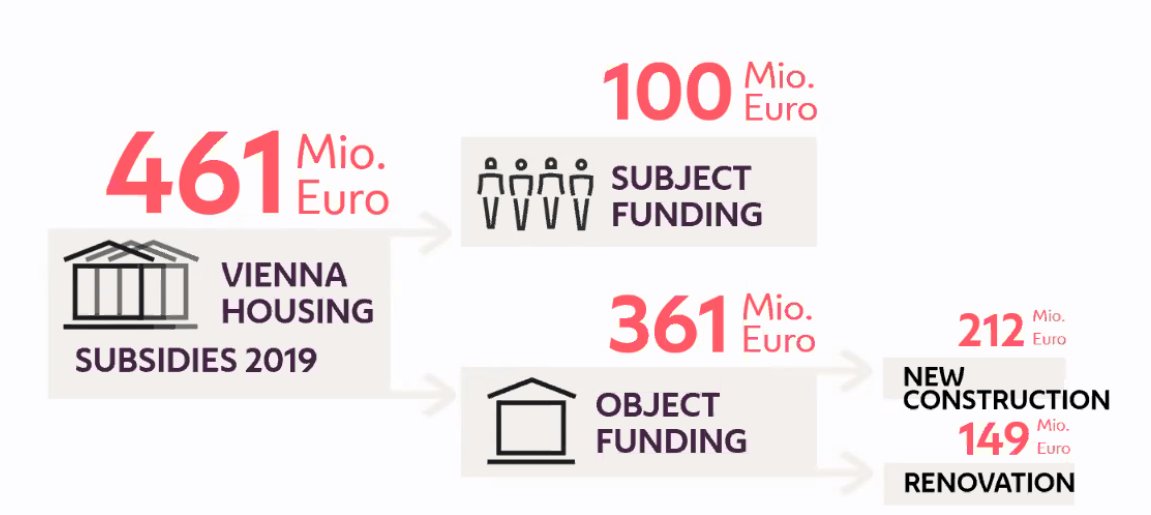
listening in to a presentation by christian schantl from wiener wohnen talk about social housing in city of vienna 🥰
funding of housing construction and retrofits is largely funded by an income tax. 0,5% of gross pay of employees, 0,5% of employers. is EUR250M per year from federal state
unlike berlin and other neoliberal regimes - never gave up housing stock.
shows stable prices + land procurement + tenant participation and protection is paramount.
also adopted new regs for new land use categories. 2/3 of all housing must include affordable housing
shows stable prices + land procurement + tenant participation and protection is paramount.
also adopted new regs for new land use categories. 2/3 of all housing must include affordable housing
leads to social co-hesion, secures jobs, basis for good social mix around city
services are not confined to working class districts, spread around city. also prevents evictions, price surges - and a good social mix.
services are not confined to working class districts, spread around city. also prevents evictions, price surges - and a good social mix.
limited profit housing act - legal framework to function as coop or corporation - to provide housing
wohnfonds wien - 1984, land for state subsidized housing. works w/ partners to procure land reserves. 3.2M sqm in hold today. still able to buy brownfield land on good terms
wohnfonds wien - 1984, land for state subsidized housing. works w/ partners to procure land reserves. 3.2M sqm in hold today. still able to buy brownfield land on good terms

vienna urban development plan - cooperation w/ other municipal development determines dev zones, distribution of funds, links to transit and infra.
all these measures - decent supply of quality, affordable housing in vienna + austria
all these measures - decent supply of quality, affordable housing in vienna + austria
city 'believes better to spend money on affordable housing' than deal w/ deficiencies of market rate market.
low rents = social housing (half rate of private market)
low rents = social housing (half rate of private market)

apartment sizes rose, and susbstandard apartments were brought into normal housing conditions through retrofits.
only 20% own homes in wien, 60% in austria.
only 20% own homes in wien, 60% in austria.
municipal + limited profit housing providers. latter is bulk of social housing in vienna, but city is building again, for very low income/formerly homeless residents. 

reason for flip: city has to fund 100% of housing. LPHA - city only needs to fund 1/3 of housing. so more housing for same investment.
high income limits - 75% of city falls within this income (net)
high income limits - 75% of city falls within this income (net)

housing municpal housing stock is located nearly everywhere. most expensive bezirk (1te) and least dense 

60s-70s
housing added to suburban areas, wealthy neighborhoods. variety of scales. focus on prefabrication.
housing added to suburban areas, wealthy neighborhoods. variety of scales. focus on prefabrication.
wiener wohnen today works w/ monuments dept in energetic retrofits, addition of elevators, improvement of restrooms, etc.
740 apts on 39 stairhouses. 78 new aufstockungen. 666 balconies. elevators for each staircase. added laundry, bike storage, barrier free apts
EUR36M cost
740 apts on 39 stairhouses. 78 new aufstockungen. 666 balconies. elevators for each staircase. added laundry, bike storage, barrier free apts
EUR36M cost

600 acres of open space and sports fields at wiener wohnen properties. manage over 1,300 playgrounds.
they have carry service for elderly during elevator issues. 👀
they have carry service for elderly during elevator issues. 👀
WW has tenant representatives in most buildings to lobby for tenants issues
vienna does not offer tax benefits for homeowners.
non-austrians are eligible for social housing if vienna residents for 2 years as primary residence.
as member of EU can't disadvantage those outside of EU.
also open municipal housing for those with refugee status.
as member of EU can't disadvantage those outside of EU.
also open municipal housing for those with refugee status.
opposed to ownership opportunities for residents in social housing - reduces the number of units available.
a few years ago, they did allow ownership opps for subsidized housing - but their funds are better leveraged in renting properties, than selling.
a few years ago, they did allow ownership opps for subsidized housing - but their funds are better leveraged in renting properties, than selling.
~10k units open up each year. ~14k need housing. so wait period is about 1.5 years - depending on housing needs or other criteria
• • •
Missing some Tweet in this thread? You can try to
force a refresh













